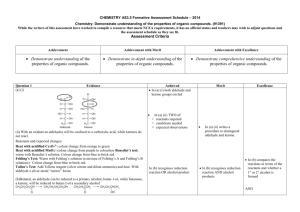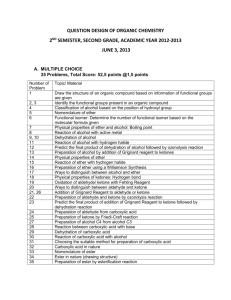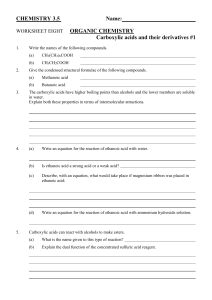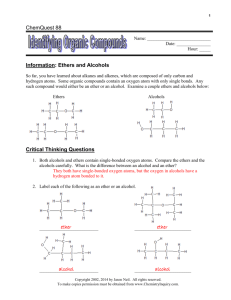Aldehyde_ketone_acylchlorides
advertisement
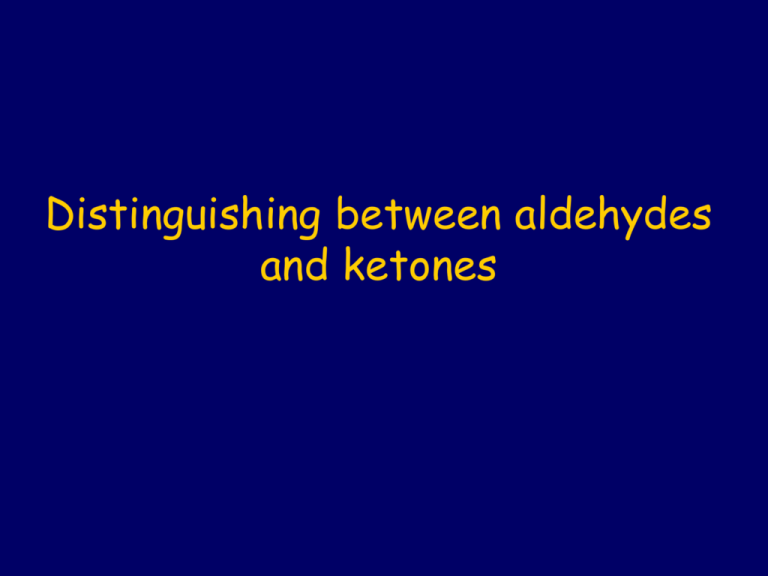
Distinguishing between aldehydes and ketones Adehydes and ketones can be structural isomers of each other. Aldehydes are produced by the oxidation of a primary alcohol and have the C=O on end carbon. Ketones are produced by the oxidation of a secondary alcohol and have the C=O on a carbon atom in the middle of the carbon chain. Aldehydes can be further oxidised to carboxylic acids, while ketones are not oxidised further. The tests we use to distinguish between aldehydes and ketones all involve oxidising the aldehyde but not the ketone. While acidified dichromate or permanganate will distinguish between aldehydes and ketones, they are strong oxidising agents which will also change colour in the presence of alcohol or other reagents. Oxidising agents which oxidise aldehydes are: • Tollen’s reagent • Benedict solution • Fehling’s solution The ‘silver mirror’. You’re more likely to get a mirror with a very clean test tube. Tollen’s reagent Tollen’s reagent is [Ag(NH3)2]+ which, when reduced, forms Ag(s). It must be freshly prepared. Silver nitrate solution A few drops of NaOH to form a precipitate. Add ammonia solution till the precipitate dissolves. Add a few drops of the aldehyde or ketone, shake, and warm gently. The ketone remains colourless, the aldehyde will react. If you are lucky you will get a ‘silver mirror’ as elemental silver forms on the inside of the test tube. Less spectacular, but just as valid is the formation of a grey or black precipitate, also of elemental silver. A grey precipitate of silver. Tollens’ Test Tollens reagent is a complex of Ag(NH3)2+ . When heated with an aldehyde a redox reaction occurs producing a silver mirror on the inner surface of the test tube. The aldehyde is oxidised to a carboxylic acid. The reduction half-equation is • Ag+(aq) + e Ag(s) •If Tollens’ reagent is heated with a ketone or an alcohol no reaction occurs. Tollens’ Test The overall reaction is : RCHO + 2Ag(NH3)2OH RCOONH4 + 2Ag + H2O + 3NH3 Silver mirror Task – write the balanced redox reactions for the oxidation of propan-1-ol to propanal using Cr2072- /H+ and give all colour changes. (X3) 3 CH3CH2CH2OH 3 CH3CH2COH + 2H 6H++ + 2e6e- Cr2072- + 14H+ + 6e- 2Cr3+ + 7H20 Full balanced redox equation 3CH3CH2CH2OH + Cr2072-+ 8H+ 3CH3CH2COH + 2Cr3++ 7H20 Benedict solution Benedict solution is an alkaline solution of Cu2+, complexed with citrate ions to keep it in solution. It is a mild oxidising agent which is reduced to Cu+. In the alkaline solution the Cu+ is in the form of Cu2O which is a brick-red precipitate which is a positive test for an aldehyde. Take about 2 mL of Benedict solution in each of two test tubes. Add a few drops of aldehyde to one tube, and ketone to the other tube, and shake to mix. Heat the mixture by putting the tubes in hot water. Shake several times to mix. A reaction has occurred in the left hand (aldehyde) tube, but not in the right hand (ketone) tube. If you wait long enough you will see the red-brown precipitate of Cu2O form. Benedicts and Fehlings Aldehydes reduce the copper (II) ions in both Fehlings and Benedicts solution to form a reddish brown copper (I) oxide which is precipitated The reaction is : RCHO + 2Cu 2+ + 2OH- RCOO- + Cu2O + 3H+ Brick red precipitate Fehling’s solution Like Benedict solution, Fehling’s contains alkaline Cu2+, but Fehling’s uses potassium tartrate to complex the copper. The mixture is freshly prepared: Pour a little Fehling’s A solution into each test tube. Add the ‘B’ solution until a precipitate forms. Keep adding ‘B’ solution until the precipitate has redissolved and the solution is a clear, dark blue. A reaction occurs in the aldehyde tube as Cu2O forms. No reaction occurs in the ketone tube. Add a few drops of aldehyde and ketone to separate tubes, shake, and heat in a beaker of hot water. Glucose is an aldehyde and will form a mirror with Tollens and will also give a positive test with Benedicts and Fehlings solutions Do you remember doing this test for sugars in yr10 ? In all of these reactions (Tollen’s, Benedict and Fehling’s), the aldehyde is oxidised to the carboxylic acid while no reaction occurs to the ketone. Task – write the balanced redox reactions for the oxidation of the oxidation of propan-2-ol to propanone using Mn04- /H+ and give all colour changes. (X5) 5 CH3CHOHCH3 5 CH3COCH3 + +10H 2H++++ 10e2e- (X2) 2MnO Mn044-- ++16H 8H++ ++ 10e5e- 2Mn Mn2+ + 8H 4H20 Full balanced redox equation 5CH3CHOHCH3 + 2Mn04-+ 6H+ 5CH3COCH3 + 2Mn2++8H20 Producing an Aldehyde from a Primary Alcohol When forming the aldehyde (ethanal) from ethanol the alcohol and dichromate must be added to the hot concentrated H2SO4 We use a distillation technique to collect a volatile product Producing an Aldehyde from a Primary Alcohol using distillation Dropping funnel with K2Cr2O7 and ethanol Distillation flask with hot H2SO4 The alcohol/dichromate mixture is added to the acid and only the first 2-3 mls of distillate is collected – why? The alcohol/dichromate mixture is added to the acid and only the first 2-3 mls of distillate is collected – why? To make sure that the immediate production of ethanal with a lower boiling point of 21 deg C was vapourised and collected quickly and was not allowed to be converted to ethanoic acid. To make sure a reaction goes to completion one such as: •Primary alcohol is completely oxidised to form a carboxylic acid •A secondary alcohol is oxidised to form a ketone You would use a reflux arrangement Making Aspirin – using methylsalicylate methylsalicylate Acetic anhydride Aspirin Carboxylic acid Carboxylic Acids O R C Named with -oic on the end They are all organic acids which are weak acids OH Reactions of Carboxylic Acids Carboxylic acids undergo 4 types of substitution reactions (of the –OH) Reactions of Carboxylic Acids 1. Forming acid chlorides from carboxylic acids – reagents are PCl5,PCl3 or SOCl2 acid chlorides are named at the end by the –oyl group Functional group of the acid chloride O R C Cl Reactions of Acid Chlorides 2. Forming esters from acid chloride – reagents are a primary alcohol Ester From acyl chloride O R C CH3COCl + CH3OH ethanoyl chloride + methanol O + HCl R’ From alcohol CH3COOCH3 + HCl methyl ethanoate + hydrogen chloride Reactions of Acyl Chlorides 3. acyl chlorides form amides – reagent ammonia and heat Functional group of the amide CH3COCl + 2NH3 ethanoyl chloride + ammonia O R C NH2 CH3CONH2 + NH4Cl ethanamide + ammonium chloride Reactions of Acyl Chlorides 4. Acyl chlorides forming N - substituted amides – reagent amine O N substituted amide CH3 O C Cl + NH2 CH3 R CH3 Ethanoyl chloride + aminomethane C NH R’ O C + HCl NH CH3 N – methyl ethanamide + hydrochloric acid Reactions of Acyl Chlorides Acyl chlorides react with water to form acidic solutions CH3 O C Cl H O H ethanoyl chloride + water CH3 O C O ethanoic acid H + HCl + hydrogen chloride Making Acyl Chlorides Carboxylic acids react with PCl3, PCl5 or SOCl2 (not HCl) to form Acyl chlorides by substituting the –OH for a Cl. CH3 O C OH Ethanoic acid + PCl5 PCl5 CH3 O C Cl ethanoyl chloride Lysergic acid diethylamide (LSD) ESTERS Carboxylic acids react with alcohols, in the presence of conc sulfuric acid as a catalyst, to form esters. The reagents are heated together to bring about a reaction. Any excess acid is neutralised by the addition of sodium carbonate. If ethanoic acid is reacted with methanol the ester, methyl ethanoate is formed. O H3C O H3C O + CH3OH C OH C H3O+ O CH3 heat H3C + H2O C O CH3 Hydrolysis of esters The hydrolysis of an ester in aqueous solution results in the break up of the ester and the formation of an alcohol and the carboxylic acid or carboxylate ion *(depending on the pH of the solution). Hydrolysis in acid produces the alcohol + carboxylic acid CH3CH2COOCH3 + H2O / H+ methyl propanoate CH3CH2COOH propanoic acid + CH3OH methanol Hydrolysis of esters Hydrolysis in NaOH soln gives alcohol + the sodium salt of the carboxylic acid. CH3CH2COOCH3 + NaOH methyl propanoate CH CH COO Na 3 2 sodium propanoate + + CH3OH methanol hydrolysing an ester (methyl salicylate) OH C O CH3 Methyl salicylate O Write the products if we hydrolyse it in acid ie H2O/H+ hydrolysing an ester (methyl salicylate) if we hydrolyse it in acid ie H2O/H+ the products are OH C O H + CH3OH O Salicylic acid methanol Write the products if we hydrolyse it in alkaline conditions ie H2O/NaOH OH C O – Na + + CH3OH O sodium salicylate methanol Turn to the last page in the booklet Ester Hydrolysis read the method (the ester is methyl salicylate) Change the method as follows: Weigh out 4.8 grams of NaOH place in boiling flask then add 20mls of water (careful! it may get very hot) Measure out and add 5mls of oil of wintergreen (methyl salycilate) to flask Place boiling chips in boiling flask and reflux carefully for 30 mins Reflux – heating mixture without losing volatile substances Distillation – using the deferring boiling points of substances to separate them Write equations using structural formulae for the formation of the following esters a) ethyl methanoate from ethanol and methanoic acid b) butyl propanoate from butan-1-ol and propanoic acid complete the following scheme giving all Formula H+ Ethanoyl chloride CH Formula? 3COCl C Reagents? 2H5OH NH3 / ethanol Ethyl ethanoate OH- C2H5OH CH3COOH + C2H5OH CH3COOC2H5 Formula? ethanamide CH3CONH2 salt + ethanol CH3COO- + C2H5OH Reagents? + Conc H2SO4 Ethanoic acid CH3COOH C2H5NH2 / ethanol N-ethylethanamide CH3CONH2C2H5 Fats and oils Fats and oils (lipids) are all triesters made from glycerol (propane-1,2,3-triol) and three long chain carboxylic acids (fatty acids) as shown below. Glycerol is an example of a”triol” which has three -OH groups present. Each of these can form an ester link with a different carboxylic acid, for example the fat called stearin. O H H C OH + R1COOH H C OH + R2COOH H C OH H Glycerol + R3COOH 3 fatty acids H2C O C O R1 HC O C O R2 H2C O C R3 Fat or oil + 3H2O Soap The three ester links present in these molecules can be broken (or hydrolysed) by heating with sodium hydroxide solution. This releases the original glycerol molecule plus the sodium salts of the long chain fatty acids which are soaps. This “saponification” process is shown in the diagram below. O H H O HH 2CC O C O O C O HC O C 2 HC H2C H2C OR 1 R2 C O OR C O 3 O C R1 H C OH H C OH H C OH H R2+ 3NaOH R3 Heat H C OH + R1COONa+ H C OH + R COONa+ 2 H C OH + R 3COONa+ H 3 soap molecules Soaps work because the tail of the molecule is a long non-polar hydrocarbon chain (from the fatty acid) which readily dissolves grease and dirt (as “like dissolves like”). Then the ionic carboxylate ion readily dissolves in water (which is also polar) and is able to carry away the grease with it in the rinse water. HO CH2 C CH2 CH2 CH CH2 CH2 CH CH CH CH2 CH2 CH2 CH2 O polar carboxylate head (dissolves in water) non-polar hydrocarbon tail (dissolves grease) CH3 CH2 bestchoice.net.nz is an excellent revision website run by the Auckland UniversityTo get on to this site you must use the following details – go to new user on main page register using the following ID: 919 Password: compound Log on using your own username and the supplied password and ID Go on and try the organic section – lasts years class went nuts on this site Go on and try the organic section – lasts years class went nuts on this site I will log on and see your progress – Log on and give it a go! There is also a scholarship section- This is your homework Tim! bestchoice.net.nz is an excellent revision website run by the Auckland UniversityTo get on to this site you must use the following details – go to new user on main page register using the following ID: 919 Password: compound Log on using your own username and the supplied password and ID Go on and try the organic section – lasts years class went nuts on this site

